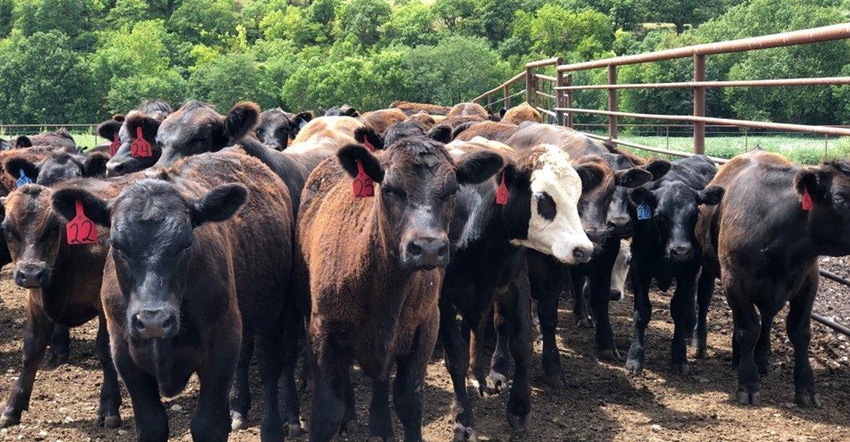Reducing stress of calves around weaning
Proper management and feed additive combination can help reduce stress in weaning calves
October 9, 2020

Sponsored Content
Reducing stress of calves around weaning
A strong immune system and resiliency in calves begins at birth when the calf receives passive transfer of antibodies through high-quality colostrum. At weaning, when the calf is removed from its dam, a stress response occurs and can range in outcomes depending on source, duration, and frequency of stress events that often leads to compromised health and performance.
Stress during weaning
Stress is considered an external influence that affects the homeostasis of an animal and may occur from persistent low-level or chronic stress or from acute stress, which occurs due to a specific event usually within a short time period. Negative effects from stress can vary from animal to animal so it is important to identify and quantify the effects of different stressors. In addition, imposing multiple stress events within a short duration, or compounded stress, can exacerbate outward clinical signs and prevalence of disease.
In regard to livestock, stress can be divided into three broad categories: psychological stress, physiological stress, and physical stress. Psychological stress is associated with fear, commingling, loud noises or being restrained; physiological stress relates to nutrient restriction or deficiencies; while physical stress is considered injury, thermal stress, hunger or thirst, fatigue and disease. During weaning and receiving, most of these stress categories may be imposed on the animal simultaneously, also referred to as compound stress, and has been linked to altering endocrine profile which can result in immunosuppression, causing poor growth and reduced immune function.
Any opportunity to reduce and spread out stress events is ideal in preventing calf morbidity and reduced growth. Consider allowing a few days to a week between each stress event including, physical separation from the dam, transportation to the feed yard and processing (dehorning, castration and vaccinations) to reduce the negative effects of compounded stress.
Management considerations
Management practices play a critical role in weaning and receiving success. There are several recommendations that can reduce calf morbidity and mortality by reducing stress and meeting nutritional needs.
Reduce psychological stress by practicing low-stress handling by moving slowly and quietly. Refrain from making loud noises or using sticks, flags, or electric prod that inflict pain and cause fear in the calves. If commingling groups of newly weaned calves, be sure that there is enough bunk space so that all the calves in the pen can eat at the same time.
Reduce physiological stress by working with your nutritionist to balance a diet before weaning. Be sure to test your feed ingredients for nutrient analysis to ensure proper formulation. Provide an open-faced, clean water trough during weaning and receiving.
Reduce physical stress by not weaning during an adverse weather event. Make sure cattle have access to clean water and good quality long-stemmed grass hay. Consult with your veterinarian for a vaccination schedule and recommendations for the prevention of diseases.
Nutrient restriction
Proper function of all physiological processes in the body, including the immune system, are dependent on the supply and availability of macro and micronutrients including, carbohydrates, lipids, protein, vitamins and minerals.
There is a strong association between nutrition and stress. Stress can be caused by the animal being in a nutrient deficient state, as well as, stressors can cause or intensify nutritional deficiencies.
Weaning and receiving imposes environmental and dietary changes that can alter rumen and gastrointestinal function due to feed and water deprivation, which may cause feed intake to remain depressed for days or even weeks once calves regain access to feed and water. During this period, calves need to replenish circulating glucose and nutrient levels and reestablish gut microbiota homeostasis for adequate immune, gastrointestinal and endocrine functions otherwise gastrointestinal and/or respiratory diseases may occur.
One of the greatest challenges is adapting calves to eating a diet made up of unfamiliar feeds out of an unfamiliar feed bunk in an unfamiliar environment. Ensuring the diet is palatable, available, and formulated to meet or exceed the calf’s nutritional needs is important.
When an animal is under stress, there is a change in endocrinal regulation that causes the release of cortisol, a stress hormone, altering the effectiveness of both the inflammatory and immune responses. An inflammatory response requires antibodies and proteins to fight against infection, disease, pathogens, and/or toxins. Therefore, when a calf has reduced intake, is nutrient deficient, stressed and being introduced to different pathogens in a new environment, the chances of sickness and death loss are high.
Starting diets are often formulated to exceed nutrient requirements or increase nutrient density to compensate for reduced intake and to supply deficient calves with adequate nutrients. For instance, many physiological processes in the body are energy and protein intensive to activate and maintain a response. Energy is required to perform most of the metabolic processes in the body, negatively affecting growth, thermoregulation and immune function when there is insufficient energy in the diet. Similarly, protein is a macronutrient that is also required in most of the physiological processes and considered an essential nutrient especially in tissue accretion, nutrient transfer, immune function and in repairing damaged cells. Furthermore, other macronutrients, vitamins, and minerals are required in adequate concentrations to ensure proper nutrient balance to perform all bodily functions.
Phytogenic Feed Additives
There are a number of feed additive options on the market intended to reduce disease, improve gut health, performance and weight gain that are commonly used in receiving calf diets. Ionophores are often included for the control and prevention of coccidiosis and for increased rate of gain. Antibiotics are used when needed for the treatment of respiratory and enteric disease but require a Veterinary Feed Directive before use. Other feed additive options include prebiotics, probiotics or direct-fed microbials, and enzymes, to name a few.
One class of feed additives that has been around for decades that is more widely used in monogastrics, but recently gaining more interest for ruminant production, are phytogenic feed additives (PFA). Phytogenic feed additives are a combination of the bioactive and flavoring components of plant-derived substances including essential oils, herbs, spices, and plant-extracts that provide anti-inflammatory, antioxidant, antimicrobial properties, which have shown to contribute to digestive and gastrointestinal health and performance in cattle.
Across species, anti-inflammatory properties found in a number of ingredients such as licorice extract, clove oil, and caraway for example, are perhaps one of the greatest contributions to animal health and performance provided by phytogenic products. Inflammation is the result of the initial phase of the immune response when an animal is faced with chronic or acute stress, microbial infection or a tissue injury. Since up to 70% of the immune system resides in the gastrointestinal tract, improving gut integrity is of utmost importance to drive optimal nutrient absorption as well as optimal immune function.
Many phytogenic ingredients provide multiple beneficial properties. For instance, vanillin is a compound often used for its sensory component providing a pleasant aroma and taste to enhance appetite and diet acceptance; however, research supports vanillin also having anti-inflammatory, antioxidant and antimicrobial effect, thus supporting immune and gastrointestinal health.
Developing an effective species-specific, targeted PFA is a complex and challenging task that requires high-level expertise in understanding phytogenic compounds. It takes a vast understanding of the ingredient properties and source, active compounds, and synergistic and interactive effects to provide a certain targeted bioactive effect in the animal. The development of an effective PFA begins with strong quality control to ensure consistency, followed by thorough research and field application supporting product efficacy.
Phytogenic feed additives formulated specifically to overcome challenges from weaning and receiving in starting calves have shown a number of positive benefits ranging from enhancing diet acceptance and stimulating feed intake, reducing oxidative stress, increasing anti-inflammatory effects, helping minimize pathogen pressure, improving gut function, and overall contributing to improved health and performance.
Conclusion
Negative effects on health and growth performance in receiving calves are often associated with reduced feed intake resulting in inadequate circulating glucose and nutrient levels accompanied with some form of stress leading to inflammation and impaired gut integrity. From disease challenge, diet changes, management, transport, metabolic disease, and others, calves are highly susceptible to performance and economic losses during weaning and receiving. Therefore, proper management and the right feed additive combination are utmost importance to successful feed yard management. Given the broad-spectrum benefits, application of the appropriate PFA in a starting program can have a key role in a preventative nutritional strategy to bolster resilience to unavoidable stress factors.
About the Author(s)
You May Also Like



